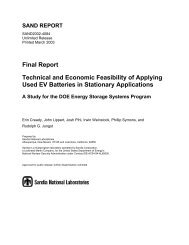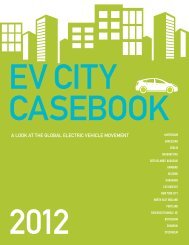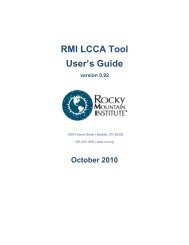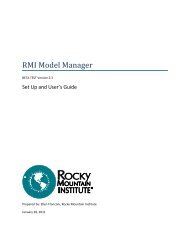Fleet Electrification Roadmap
Fleet Electrification Roadmap
Fleet Electrification Roadmap
- No tags were found...
Create successful ePaper yourself
Turn your PDF publications into a flip-book with our unique Google optimized e-Paper software.
48 part one: the case for fleetsfleet electrification roadmap 49ABSTRACTFor electrification to meaningfully impact U.S. energy andnational security, grid-enabled vehicles will ultimately needto succeed in the personal-use passenger vehicle market.However, during the early development of the electric vehicleindustry, while battery and vehicle costs remain high, othermarket segments could prove critical for driving demand.In particular, commercial and government fleets couldrepresent major early adopters of grid-enabled vehicles.The lower fuel and maintenance costs associated withgrid-enabled vehicles—particularly EVs—could provide morenear-term economic value for fleet operators than typicalconsumers, particularly in higher mileage applications.Moreover, the key challenges facing widespread consumeradoption, including access to infrastructure, range anxiety,and the higher upfront costs of the vehicles themselves—might be more easily managed by fleet owners. Finally,the implementation of corporate sustainability initiativesin a number of American businesses could provide addedmomentum for the purchase of highly efficient electric drivevehicles in fleet applications.CHAPTER 1.1OverviewThere were more than 16 million public and private fleet vehicles on the road inthe United States in 2009. 1 While the size of individual fleets varies significantly,the top 50 fleet operators together manage more than half a million vehicles. 2<strong>Fleet</strong> vehicles perform a variety of missions for federal,state, and local government, and for companies thatare familiar to nearly all Americans. They are postaldelivery vehicles, utility and telecom service trucks,pharmaceutical sales vehicles, urban delivery vans,and more.Different fleet operators take different approaches tothe way they acquire, operate, and manage their vehicles.Miles driven per day, refueling options, and the amountof time vehicles spend parked or idling can vary significantlyby operator and industry. <strong>Fleet</strong> operators also takedifferent approaches to balancing the tradeoffs betweenoutright ownership and leasing depending on financingstrategies and cost considerations. In 2009, 80 percent ofthe fleet cars and class 1-5 trucks on the road in the UnitedStates were privately owned; 20 percent were leased. 3The top 10 fleet leasing companies own and operate nearly3 million vehicles in total. 4The concentration of buying power associated withfleet operators and fleet management companies representsa significant opportunity to assist the early developmentof the electric drive vehicle industry. Moreover, fleetstend to possess a handful of important characteristics thatmay make their operators more likely than typical consumersto take on the potential risks of electric drive vehicles.The most significant challenges facing consumeradoption of electric vehicles today are the high upfrontcost of the vehicles themselves—a cost driven largely bybatteries—and the absence of publicly available refuelinginfrastructure. <strong>Fleet</strong> operators represent a customer segmentthat may be able to move past both challenges morequickly than typical consumers.1 PRTM analysis; This figure is derived from a composite of datasources, including R.L. Polk, Automotive <strong>Fleet</strong>, U.S. General ServicesAdministration, GE Capital, Utilimarc, and others.2 Bobit Publishing Company, 2010 Automotive <strong>Fleet</strong> Factbook (AFB),available at http://www.automotive-fleet.com/Statistics/3 Id. at 9.4 Id. at 44.By serving as a first market for electric drive technologies,fleet operators could generate a number ofspillover benefits for the broader consumer market, easingadoption on a wider scale. <strong>Fleet</strong> operators representa potential catalyst for the industry-wide economies ofscale that will benefit the consumer electric drive marketwith lower prices. If plug-in vehicle adoption amongfleet operators reached even 4 percent of new acquisitionsby 2015, the fleet industry could generate demandfor as much as 3,000 MWh of battery capacity. Increasedvolumes from fleet orders will also reduce the costs ofelectric powertrain components.A similar impact could be realized in charging infrastructure.While fleet operators will benefit from singlepoint installation, the need to charge multiple vehiclessimultaneously in some instances could necessitate largecharging unit purchase orders, helping to accelerate thedevelopment of critical installation experience and drivingearly volume production of charge units.Finally, fleet operators could improve consumers’ perceptionof electric-drive vehicles by increasing their publicexposure and facilitating interaction with a new technology.Urban parcel deliveryvehicles display some ofthe most familiar brands3 Millionin corporate America, andthey are a common sighton city roads and highwaysacross the United Number of vehicles owned and managedStates. Typical consumers by the top 10 fleet leasing companies.interact with utility andtelecommunications service vehicles in their neighborhoodsevery day. Rental cars, taxi cabs and transit vehiclesoffer even greater exposure. By demonstrating the safety,reliability, and real world benefits of electric drive technologies,fleet operators can dramatically enhance consumers'perceptions of HEVs, PHEVs, and EVs.
















